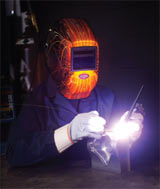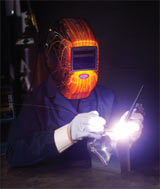
Enjoying the Advantages of PAPRs
Versatile but expensive, these units provide full-face protection and comfortable, cool air to their wearers.
 PAPR. No, it has nothing to do with the clapper (Clap On, Clap Off), but it does have something to do with helping some of your employees breathe easier. A PAPR (pronounced PAP-er), or Powered Air Purifying Respirator, is a respirator of convenience for those employees who may be problematic into fitting in a regular respirator facepiece or for those jobs where you need cool air or where you need to have a high assigned protection factor (APF; more on that later).
PAPR. No, it has nothing to do with the clapper (Clap On, Clap Off), but it does have something to do with helping some of your employees breathe easier. A PAPR (pronounced PAP-er), or Powered Air Purifying Respirator, is a respirator of convenience for those employees who may be problematic into fitting in a regular respirator facepiece or for those jobs where you need cool air or where you need to have a high assigned protection factor (APF; more on that later).
OSHA requires that when an employee notifies his/her employer that the fit of a respirator is unacceptable, the employee needs to be able to select a different facepiece.1 What OSHA doesn’t say is, what do you do when employees do not pass the fit test? They have been medically cleared by a physician, yet they continually smell and taste the Bitrex® during qualitative fit testing with a tight-fitting half-face and then full-face respirator, or you’ve used a quantitative unit and the protection factor is very low.
Case Study
Such was the case with one employee whom I knew. We’ll call him Lenny in this article. Lenny was a quality control technician for the incoming raw materials at a pharmaceutical company. When new raw materials were received, it was Lenny’s job to sample them and send the samples to the QC lab for analysis.
Consider the high blood pressure pill you take. It may be a 5 milligram pill, which means that in a pill that might weigh 1,000 milligrams (1 gram), there are 5 milligrams of the active ingredient and 995 milligrams of fillers, binders, colorants, and similar types of non-active ingredients.You take one pill a day, and your blood pressure stays in control. What would happen if you were to breathe in the pure dust of that active ingredient? What would happen to your blood pressure?
That is the respiratory challenge that faced Lenny every day. He needed to be protected. In addition, the possibility of getting any of these raw materials in his eyes would not have been good for him, either. What to do?
I attempted to fit-test Lenny in a full-face respirator with HEPA filters. Unfortunately, Lenny is a person whose face is long and lean. I tried two different brands of full-face respirator, but neither gave Lenny the protection he needed. I called my local safety supplier and told him the problem. “Why not try a PAPR?” he suggested. So that’s what we did.
I selected a unit that required one large filter and utilized a hood assembly. Battery life was rated at eight hours plus, and many of the components were disposable, had contamination covers, or could be decontaminated. (In pharmaceutical processing, contamination is everyone’s fear.)
Elijah was another employee who was a problem to fit.His religion forbade his shaving, and he wore a head covering that varied in size. With his beard, any type of tight-fitting respirator was out of the question. That left the PAPR with a loose hood to give him the protection that he needed.
Why are PAPRs the “wonder tool” of PPE? One reason is their versatility. PAPRs can be hooked into halfface, full-face, or hood-type facepieces, including welding helmets; they are self sufficient with a battery pack worn by the user, and an assortment of filters and cartridges are available. They provide cool air to the wearer, and they give Assigned Protection Factors (APF) values from 25 to 1,000, depending upon the facepiece used.
Still, workers may not welcome them in all settings. “My experience with PAPR usage has been mixed. They can be bulky and have employee resistance in hot weather,” said Mike DeVivo of J & M Safety Consulting in Waterbury, Conn.2
“Many of the PAPRs 3M is selling is to help improve employee comfort, rather than primarily for respiratory protection,” said Kevin McGuigan, supervisor of Product Marketing for Powered and Supplied Air and Welding Products for 3M.“They provide eye and full-face protection, in addition to the cooling air circulating around the user’s head. They help keep employees clean.”3
Assigned Protection Factors
Another benefit to PAPRs comes from their having a wide range of assigned protection factors. In August 2006, OSHA promulgated its final rule on assigned protection factors (71 FR 50121)4. The Respiratory Protection Standard, 29 CFR 1910.134, Table 1, provides a listing of APFs for the various combinations of facepieces and types of respirators.
For a PAPR, the APFs range from 25 to 1,000. The only respiratory system with a higher APF is a self-contained breathing apparatus (SCBA) utilized in a positive pressure mode, thus providing an APF of 10,000.
OSHA allows an APF of 1,000 for a PAPR if the manufacturer has test results showing that actual users can achieve that number (note 4 to Table 1)4. Several PAPR manufacturers publish that information, either in instructions for the units or on their Web sites.
Cost and Payback
Half-face respirators can cost from $10 to $25, depending on brand and quantity purchased, while full-face units range from $120 to $190, not including filters or cartridges. A complete PAPR kit consists of a facepiece or hood, connecting tube, battery pack, and fan/filter holder. The cost is anywhere from $1,000 to $1,500.
For many companies, that is an exorbitant price to pay. But is it really? In the case of Lenny, a PAPR presented a twofold benefit. He had respiratory protection that would really protect him, and he got some extra comfort from the cooling air. What is a reduced chance of a worker’s compensable illness and increased productivity worth?
Filters or cartridges are additional. Depending upon the unit, you may be able to use the same type of filters/cartridges that you now use on your other tight-fitting respirators, either two or three.Other units use one special larger filter/cartridge, so the cost of the filters/cartridges and your change-out schedule need to be considered.
“When customers call us in, we have a productivity model and we can use actual cost and production information to show them where they can get a payback, sometimes as quickly as three to six months,” McGuigan said.
Maintenance and Upkeep
As with regular tight-fitting respirators, the end user does a daily inspection before and after use. The user generally can change bands or fittings should any of those get damaged. Any other repairs should be performed by a trained, qualified person, or the complete unit should be replaced.
A PAPR, however, has a battery pack and fan unit that has to be inspected and the batteries kept on charge when the unit is not in use. If PAPRs are used only infrequently, some of the batteries—especially of the nickel-cadmium variety—can develop a memory.To prevent that requires that the batteries be periodically turned on, used under load, allowed to drain down, and then put back on for a full recharge.
To ensure the PAPR fan is operating correctly, a calibration check device consisting of either a rotometer or a floating ball comes with each unit and should be checked prior to use, making sure that the fan volume is correct. If it is too low, the battery may need to be fully charged, or there may be a blockage in the fan.
Another way I was able to keep the batteries fully charged was to place them on a timer. The timer was set for 12 hours on and 12 hours off. This way, the batteries were not getting overcharged, and I did not have to babysit them.They got some passive exercise when the power was off. (All batteries slowly lose some charge when they are not being used.Nickel-cadmium can lose up to 1 percent of its charge per day.)5
One manufacturer is advertising a lithium battery pack for its one-time emergency response PAPR units. This company says,“The non-rechargeable lithium battery . . . is expected to provide 12 hours of service when new.During storage, at room temperature, it will lose approximately 1% of its charge per year. . . .Therefore, a battery stored at 20° C (68° F) for 10 years will lose up to 10% of its charge.”5
Summary
For those who are hard to fit with a respirator, for those with facial hair, and to improve your employees’ comfort and increase productivity, a PAPR may be just the respirator for your program. Do your homework, start with a small test group, and you may find that PAPRs deliver.
References
1. 29 CFR 1910.134(f)(4): If after passing a QUALITATIVE (QLFT) or QUANTITATIVE (QNFT), the employee subsequently notifies the employer, program administrator, supervisor, or PLHCP that the fit of the respirator is unacceptable, the employee shall be given a reasonable opportunity to select a different respirator facepiece and to be retested.
2. Mike DeVivo of J & M Safety Consulting in Waterbury, Conn., ([email protected]); e-mail correspondence, August 2008.
3. Kevin McGuigan, supervisor of Product Marketing for Powered and Supplied Air and Welding Products for 3M; telephone conversation, August 2008.
4. OSHA, 29 CFR Parts 1910, 1915, and 1926: Assigned Protection Factors; Final Rule. http://tinyurl.com/okemr. (Note: tinyurl.com is a shortcut to the longer OSHA URL. It helps prevent errors in getting to long Web addresses.)
5. 3M Technical Data Bulletin, #151, PAPR Management and Planning for First Responders, March 2002, page 1.
This article originally appeared in the November 2008 issue of Occupational Health & Safety.